Sony A900 Full-Frame: Hands-On Preview
by Wesley Fink on September 12, 2008 12:00 AM EST- Posted in
- Digital Camera
Full-Frame, 24.6MP, and SteadyShot Integrated IS
The A900 is the first Sony DSLR to feature a full-frame sensor. The sensor is approximately the size of a frame of 35mm film, which is 24x36mm.
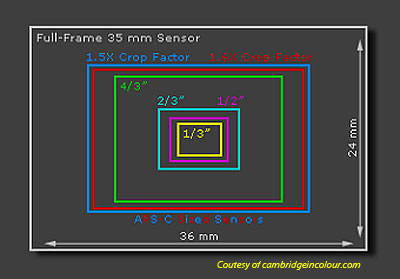
Most digital cameras today use a sensor closer to APS-C size. As a result, lenses mounted on APS-C DSLRs behave as if they are 150% to 200% longer than the marked focal length. Other Sony DSLR cameras, like the A700, also feature a 23.5x15.6mm APS-C sensor.
In the computer world, increasingly smaller traces mean higher density, more transistors, and generally better and faster performance. However, the digital sensor is not a digital device; it is an analog device that gathers light and turns it into a digital signal. Sensors are the reverse of digital electronics in that larger is almost always better in sensors, with everything else equal. More details on how digital sensors actually work can be found in The Digital Sensor.
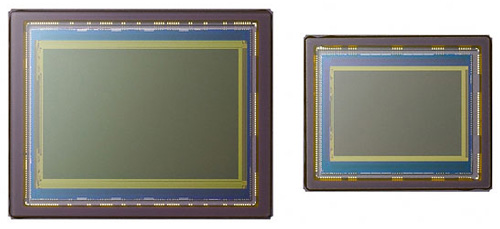
| DSLR Sensor Comparison | ||||
| Camera | Effective Sensor Resolution | Sensor Dimensions and Area |
% of Full-Frame | Sensor Density (MP/cm2) |
| Olympus E-520/E-3 | 10 | 13.5x18 2.43 cm2 |
28.10% | 4 |
| Canon XSi | 12.2 | 14.8x22.2 3.28 cm2 |
38.00% | 3.7 |
| Sony A350 | 14.2 | 15.8x23.6 3.72 cm2 |
42.90% | 3.8 |
| Pentax K20D | 14.6 | 15.6x23.4 3.65 cm2 |
42.20% | 4 |
| Canon 50D | 15.1 | 14.9x22.3 3.32 cm2 |
38.40% | 4.5 |
| Sony A700, Nikon D300, Nikon D90 | 12.3 | 15x23.5 3.66 cm2 |
42.40% | 3.3 |
| Nikon D700/Nikon D3 | 12.1 | 24x36 8.64 cm2 |
100% | 1.4 |
| Canon 5D | 12.7 | 24x36 8.64 cm2 |
100% | 1.5 |
| Canon 1Ds Mark III | 21.1 | 24x36 8.64 cm2 |
100% | 2.4 |
| Sony A900 | 24.6 | 24x35.9 8.61 cm2 |
100% | 2.9 |
The last column in the chart is the one that tells the story most accurately, however. Here the effective sensor resolution is divided by the sensor area to yield a sensor density. The lower the density, the larger the individual pixel size, and the more data that pixel can gather - all else being equal. There are a few surprises here, such as the Sony A350 being essentially the same density as the Canon XSi, and the new Canon 50D having the highest density of any current DSLR camera.
The last column does put into perspective the true potential of the full-frame sensor and shed some light on the true meaning of Sony's 24.6MP A900 sensor. At 2.9MP per cm2, the A900 still exhibits a lower density and theoretically better high ISO performance that any current APS-C DSLR. This is very much at odds with the ridiculous claims many on the web are making about Sony going too high in resolution on the A900. In fact, sensor density on the A900 is lower than the 10MP Canon 40D, which is 3.1.
The point is that any issues Sony may be found to have with noise are not the result of pixels being "too small". All else being equal the high ISO noise should be at least as good as an 8 to 10MP Canon sensor. Where the Sony does suffer is in comparison to sensor density of other full-frame sensors. In that metric the Sony has twice the pixels per cm2 of a Nikon D3/D700 and Canon 5D, and keeping up in high ISO performance with those cameras would be quite a feat.
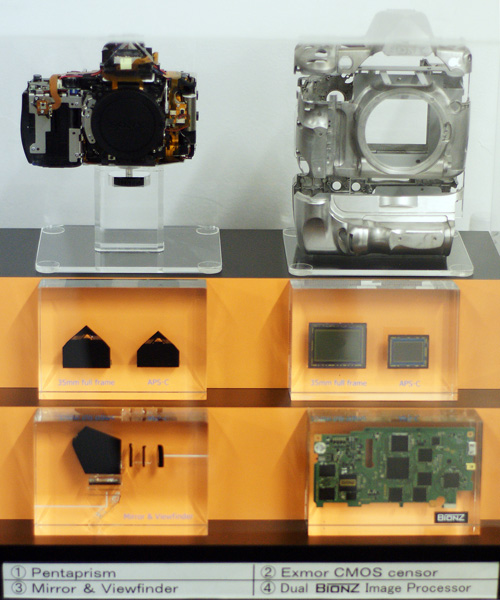
Moving a digital SLR camera to full-frame involves a lot more than just the sensor, however. Everything is bigger, heavier, and more difficult to accomplish. You can clearly see some of those challenges in this Sony case comparing sensors, pentaprisms, the microprocessor to move the huge increase in data (dual BIONZ), and the motors to control the in-camera image stabilization (IS). Rumors were rampant for months that Sony just could not get their signature SteadyShot IS to work in full-frame, which would have been a major failing had it turned out to be true. Now that we have used the A900 hands-on we can report that SteadyShot is definitely working as it should, and Sony still claims a 2.5 to 4.0 stop improvement in hand-holdability in the full-frame A900.
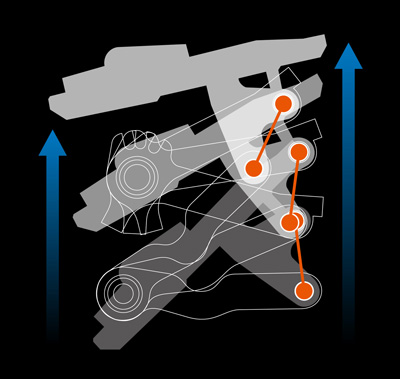
To accomplish this Sony employed a parallel-link to move instead of flip the mirror. This reduced vibration substantially to reduce the demands on SteadyShot. It also had the benefit of allowing a shorter front to back dimension while still utilizing a full-frame mirror.
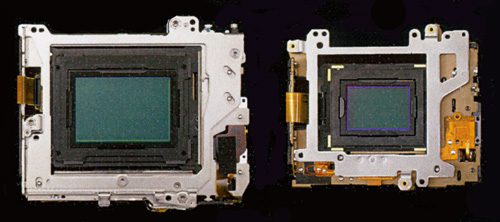
The second innovation was the sensor motors themselves. Since SteadyShot is controlling heavier components in even greater motion than APS-C, the motors required a 50% increase in output. Amazingly, the motors were beefed up, twice as many pixels are being captured and processed with dual BIONSZ processors, and with the same NP-FM5000H battery used in the A700, A350, A300, and A200 they extended the expected battery life in the A900 to 850 shots. Even if you're predisposed to hate Sony because you are a loyal Canon fan, you have to admire the engineering that went into solving many of these challenges.










53 Comments
View All Comments
roweraay - Saturday, September 13, 2008 - link
Obviously, an APS-C 100% viewfinder is only 42% of the size of a Full-frame viewfinder at equivalent magnification. That is a point one has to really keep in mind.Note that the 100% viewfinder at 0.74x magnification, is larger than the viewfinders in the Nikon D3 or the Nikon D700 or the Canon 1DSMKII or the Canon 5D.
In fact, the Sony A900's viewfinder is the 2nd largest Viewfinder EVER, in any DSLR, with the $8000 Canon 1DSMKIII slightly edging it out in size. Note that the precision assembly required and the tighter manufacturing tolerances in a 100% viewfinder, makes it head-and-shoulders above even a 95% viewfinder.
The viewfinder sizes are as below:
Nikon D3: 100% VF with 0.7x magnification
Nikon D700: 95% VF with 0.72X magnification
Canon 5D: 96% VF with 0.71x magnification
Canon 1DSMKII: 100% with 0.7x magnification
Canon 1DSMKIII: 100% VF with 0.76x magnification
Kudos to Sony for getting this in at such a price and specification. Coupled with the fact that only the Sony Full-frame will have stabilized 35mm primes, 50mm primes, 85mm primes, 135mm primes, along with a stabilized 16-35 f/2.8, a stabilized 24-70 f/2.8 etc., makes this a VERY appealing product.
I personally DEFINITELY intend to "vote" for this with my money.
roweraay - Saturday, September 13, 2008 - link
Also note that the Sony Full-RAW files are around 40MB in size, per file, when it comes to the A900.So when shooting RAW at 5FPS, that is around 200MB of image data PER second.
When shooting RAW+JPEG at 5FPS, we need to add another 100MB to the above number, thus taking us to 300MB of data PER SECOND.
What the above means is that the data pipeline architecture needed to support 24.6MP of resolution at 5FPS, is literally equivalent to the data pipeline architecture of MUCH pricier products like the 1DSMKIII and the Nikon D3. This is WAY superior to the architecture in products like the Nikon D700 or the Canon 5D (current version).
Also, dpreview tests show that the A700 is WRITING to the CF-card at around 37MB/Sec, when tested with a 40MB/Sec Sandisk Extreme IV card (max speed: 40MB/Sec). In other words, the A700 is WRITING to the card at almost the full speed of a 266x 40MB/Sec UDMA card. I would assume that with a 300x 45MB/Sec card, it very well might have broken the 40MB/Sec write-to-card speed barrier.
When mentioning the above write-to-card speeds, I need to point out that the above speeds are faster than any other dSLR, regardless of cost. It is faster than the Canon 1DSMKIII, 1DMKIII, Nikon D3, Nikon D300, Nikon D700 etc. Only the Nikon D3/D300 come relatively close to the A700's write-to-CF-card speed.
I would not be surprised if the A900 is even faster, if we employ a 45MB/SEC 300X card to test its write-to-card speed.
I would venture that Sony is employing the full power of its electronics expertise in their high-end pro/semi-pro level cameras.
chiew - Sunday, September 14, 2008 - link
wow...it can beat a three year old camera in write speed. kudos, sony!roweraay - Sunday, September 14, 2008 - link
Maybe you did not read it well enough. ;)The one-year-old Sony A700, is beating every single DSLR *ever* made, regardless of pricepoint, in the write-to-card speed.
The A900 could match it or maybe be even faster !
chiew - Sunday, September 14, 2008 - link
how much does write speed really matter, though?is there any data on 1D mkIII write speeds? because based on more important things, like frames per second, color depth, etc, cameras like the 1d mkIII and nikon d3 have to write pretty damn fast. . i know write speed to card is part of the pipeline, but as long as the camera writes fast enough to keep up with its rated specs, i don't see why write speed is such a huge deal
a700: 5 frames per second, 12 bit, 12 mp
40d: 6.5 fps, 14 bit, 10 mp
1d mkIII: 10 fps, 14 bit, 10 mp
one example of a camera that doesnt keep up is the d300, which when switched into 14 bit mode, cannot keep up with its 6 fps.
Wesley Fink - Saturday, September 13, 2008 - link
A catalog photographer at the Sony presentation has been shooting with the A900 for several weeks. He was a Canon 1Ds Mark III user He also was a user for many years of Hasselblads with Zeiss glass and digital backs. The Zeiss lenses were a big part of his move to Sony.This same photographer quoted the largest capture file size as 68MB, but your 40MB is much closer to the published specs in the A900 brochure. Those charts show a 4GB card can capture 105 full RAW files or 157 cRAW.
I suspect the PRO was referring to the file size of a finished TIFF saved from processing a RAW image since he mentioned he used Capture One for most of his PP. Frankly I didn't know Capture One supported the A700 until he assured us he had used it for his PP with the A700. Capture One will also apparently support the A900 by the time it is shipping. Since the program is widely used by Pros that will be important to many.
roweraay - Sunday, September 14, 2008 - link
The biggest draw for me are the Zeiss AF lenses in the Sony range, too. Specifically the CZ 85mm f/1.4 Planar, the CZ 135mm f/1.8 Sonnar, the CZ 24-70 f/2.8 SSM Vario-Sonnar and the 16-35 f/2.8 SSM Vario-Sonnar. I already have the 85mm and the 24-70 f/2.8 with me and will add the 135 (shortly) and the 16-35 f/2.8 when it becomes available.There were some rumors that there is also an upcoming Carl Zeiss 70-200 f/2.8 SSM Vario-Sonnar, which if true, would provide f/2.8 from 16mm to 200mm. This lens is rumored to replace the current 70-200 f/2.8G SSM (from the Konica-Minolta era).
Wesley Fink - Saturday, September 13, 2008 - link
D3 and not D4. I wish I really had a D4 but it was just a slip of the finger.Rashkae - Saturday, September 13, 2008 - link
Sony does not target this at Pros. It's officially semi-pro, and they said "it's a camera that even pros might want to use".And have you held it? Used it? I have. It's build is so seriously solid it impressed a die-hard D3 user. Don't dismiss the ruggedness of this body, when even the lower-spec A700 survived in conditions the Canon 1Ds-MkIII died in.
melgross - Wednesday, September 17, 2008 - link
They are calling it a pro body here. That's what I'm talking about.And thats pure BS about the A700 vs the 1Ds. I've used the 1Ds and you could use it as a hammer to smash the A700 to a pancake, then go out to shoot some sports.